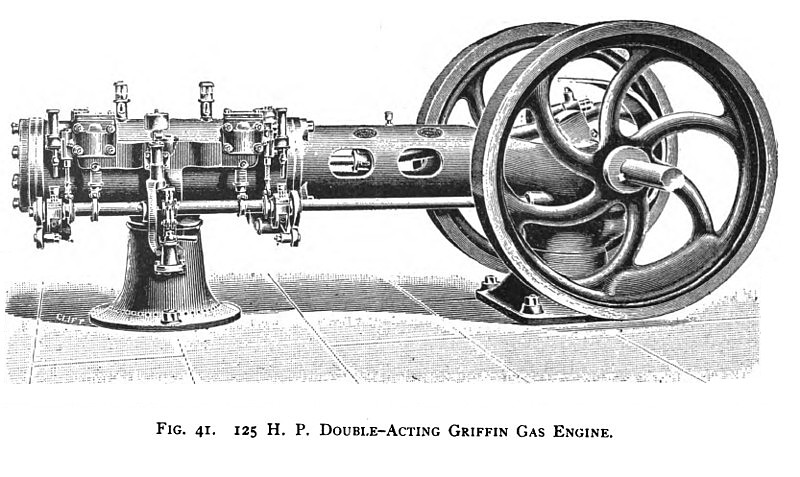|
Title: |
1894 Article-Griffin Engineering Co., Double Acting "Griffin" Gas Engine |
|
Source: |
Proceedings of the American Gas Institute, V 10 #2, Apr 1894, Appendix pgs. 80-81 |
|
Insert Date: |
3/11/2014 1:20:41 PM |
Although this engine has not yet appeared upon the market, I feel that mention of it may properly be made, as I am told that two prominent gas men in this country are now engaged in testing sample engines that are in the United States, with the full expectation of organizing a company and placing the engine upon the market. In any event it is worthy of note, as apparently the one gas engine that has attained commercial success, (some 2,000 or more having been sold) that is double acting: i.e. has a closed cylinder with front head, and explodes each side of the piston, hence more nearly resembling the steam engine action, indicating one great step where more power than heretofore, will in the writer’s opinion, ultimately be regularly had from a given size and general weight of engine. The great trouble so far has been, that, in double acting gas engines the intense heat of combustion (some 2,600° to 2,900° F.) has destroyed the lubrication and packing of the piston rod and stuffing box. Special water cooling glands are relied upon to cure this point in the Griffin form.
The majority of the Griffin engines have been of the three-cycle class, the action at each end of the cylinder being as follows : the drawing in of the charge ; compression; ignition and explosion ; exhaust; (so far like the Otto.) Instead of then repeating, a further revolution is first interposed during which a charge of pure air is drawn in for scavenging and is ejected. Thus, three revolutions are passed before the cycle is repeated, but as the opposite end of the cylinder is performing the same cycle, an impulse is secured every 1½ revolutions and no auxiliary compression chamber is needed. The latest current form, however, has reverted to the Otto cycle. The engine has conical, spring valves of the lifting type, actuated by cams; a special cylinder lubricator and a small slide valve controlling a tube ignition. Governing is by cutting off the gas supply, thus missing explosions, for ordinary work, and by dilution for electrical plants. Figures of 17 feet per Brake H. P. on the latest form of 50 H. P. size are given as the engine’s efficiency. Very steady operation is a feature. It is said that in England this engine is largely used, and that the makers are prepared to build up to 500 H. P. in single cylinder engines. As a departure from existing lines, and a praiseworthy effort to secure double action in the gas engine, it is of great interest, as, also, from the fact that as far as I can learn, the largest gas engines yet made have been upon this form, viz.: 2 twin connected 300 H.P. engines giving 600 H.P.
Although this engine has not yet appeared upon the market, I feel that mention of it may properly be made, as I am told that two prominent gas men in this country are now engaged in testing sample engines that are in the United States, with the full expectation of organizing a company and placing the engine upon the market. In any event it is worthy of note, as apparently the one gas engine that has attained commercial success, (some 2,000 or more having been sold) that is double acting: i.e. has a closed cylinder with front head, and explodes each side of the piston, hence more nearly resembling the steam engine action, indicating one great step where more power than heretofore, will in the writer’s opinion, ultimately be regularly had from a given size and general weight of engine. The great trouble so far has been, that, in double acting gas engines the intense heat of combustion (some 2,600° to 2,900° F.) has destroyed the lubrication and packing of the piston rod and stuffing box. Special water cooling glands are relied upon to cure this point in the Griffin form.
The majority of the Griffin engines have been of the three-cycle class, the action at each end of the cylinder being as follows : the drawing in of the charge ; compression; ignition and explosion ; exhaust; (so far like the Otto.) Instead of then repeating, a further revolution is first interposed during which a charge of pure air is drawn in for scavenging and is ejected. Thus, three revolutions are passed before the cycle is repeated, but as the opposite end of the cylinder is performing the same cycle, an impulse is secured every 1½ revolutions and no auxiliary compression chamber is needed. The latest current form, however, has reverted to the Otto cycle. The engine has conical, spring valves of the lifting type, actuated by cams; a special cylinder lubricator and a small slide valve controlling a tube ignition. Governing is by cutting off the gas supply, thus missing explosions, for ordinary work, and by dilution for electrical plants. Figures of 17 feet per Brake H. P. on the latest form of 50 H. P. size are given as the engine’s efficiency. Very steady operation is a feature. It is said that in England this engine is largely used, and that the makers are prepared to build up to 500 H. P. in single cylinder engines. As a departure from existing lines, and a praiseworthy effort to secure double action in the gas engine, it is of great interest, as, also, from the fact that as far as I can learn, the largest gas engines yet made have been upon this form, viz.: 2 twin connected 300 H.P. engines giving 600 H.P. |
|
 1894 Griffin Engineering Co., Double Acting "Griffin" Gas Engine
1894 Griffin Engineering Co., Double Acting "Griffin" Gas Engine
|
|